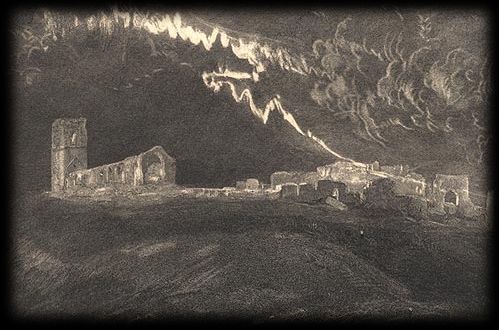 Copyright © 2014 Turner Museum |
||
|---|---|---|
|
Wickwich is based upon Dunwich in Suffolk, an ancient town that had been the capital of the Kingdom of East Anglia during the Anglo-Saxon period and was one of the ten largest towns in England in the early middle ages. The area’s battle with the sea dates back to Roman times and the Domesday book records the loss of over half the borough’s taxable farmland between 1066 and 1086. The first significant loss of buildings occurred during a three-day storm in 1286 that swept away the lower parts of the town and silted up the Dunwich River, thereby destroying its harbour and the source of its prosperity. Over subsequent centuries continuous coastal erosion reduced the town to just one quarter of its original size by 1602. The last church within the ancient town, All Saints, was abandoned in the 1750’s and its tower collapsed into the sea in 1919, leaving just a single buttress that was eventually relocated to the grounds of the Victorian St James’ church, in the village, as a monument to the lost city. A detailed history of the town can be found in Rowland Parker’s extremely readable Men of Dunwich: The Story of a Vanished Town (Paladin Books ISBN 0586083308). Dunwich Museum, “the small museum with a big story”, has numerous Roman, Saxon, Medieval and Elizabethan exhibits and is well worth a visit – www.dunwichmuseum.org.uk. The website charting the arch-aeological research of the site, Dunwich – The Search for Britain’s Atlantis, is also very informative with up to date details of the underwater excavations - http://www.dunwich.org.uk Local legend has it that at times of danger, or around midnight at certain tides, you can still hear the bells of Dunwich’s drowned churches ringing beneath the waves. Unsurprisingly Dunwich has provided inspiration to numerous artists, poets and writers, most notably as the subject of JMW Turner’s evocative painting Dunwich and as the setting for M.R.James’ classic ghost story Oh Whistle and I'll Come to You, My Lad. |
||

|